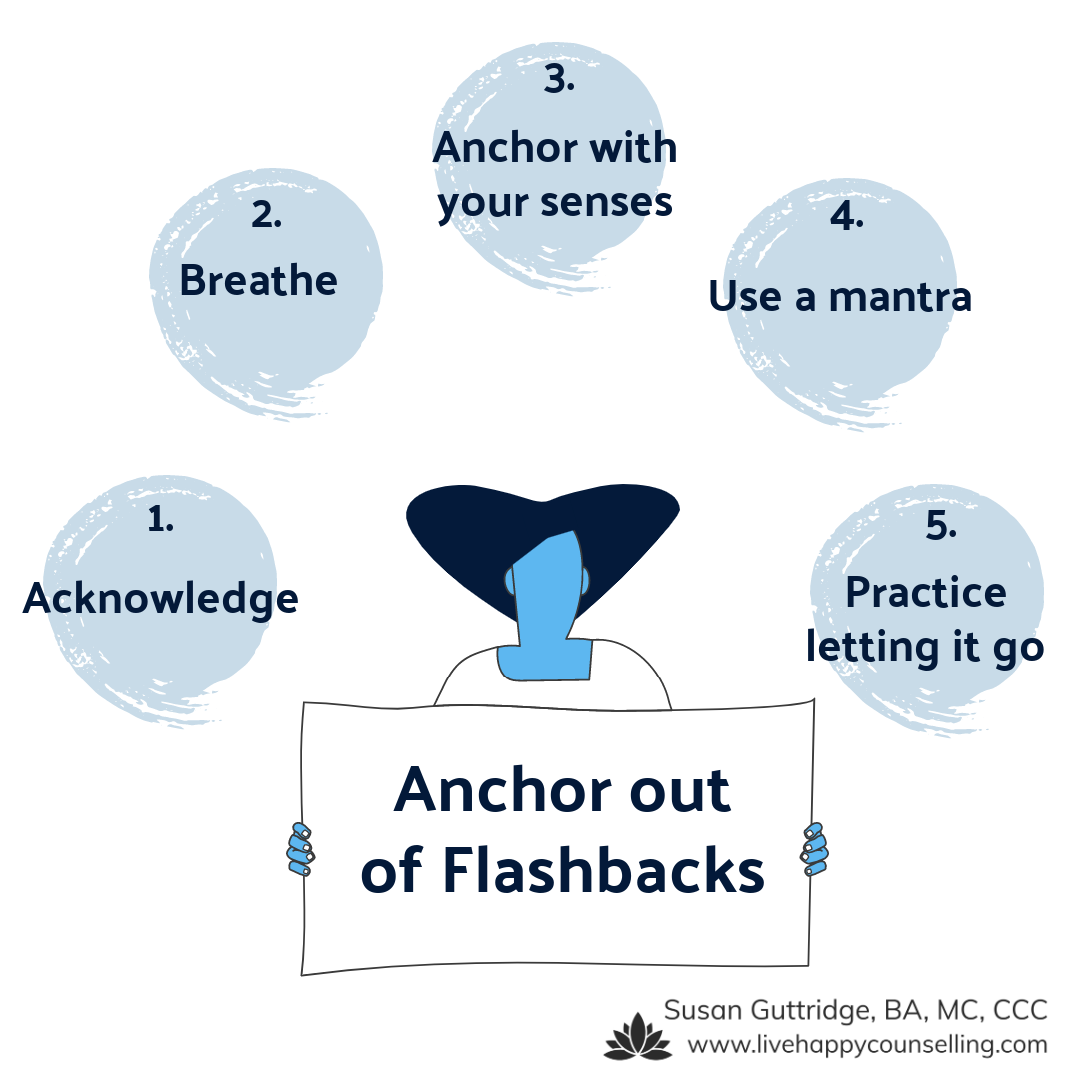AcknowledgeThe images, thoughts, memories, and physiological sensations that accompany a flashback can make you feel as though the trauma is happening right now. Acknowledge you are experiencing a flashback with kindness (i.e. “There I go again, this is a flashback”). Although this sounds simple, the natural tendency is often to push intrusive images out of awareness. However, suppression and denial just cause the imagery to come back stronger and more frequently. Acknowledge the flashback, and notice the emotions, thoughts, and physiological sensations that go along with it. Even though I’ve listed using a mantra farther down in this article, often it can be helpful to use it when you acknowledge the flashback, because it helps establish that the trauma has passed – “It’s over”. And, the mantra can be repeated during the next step: slowing and following the breath. BreatheTake a deep, full breath in through your nose – one that you feel right into your abdomen – and exhale through your mouth. When we feel out of control, our breathing also tends to be out of control. The experience of a flashback can cause emotional flooding, and can immediately trigger a change in our breathing: this might look like extremely rapid, shallow breathing, or breath holding. Both of these can lead to a shortness of breath feeling and can cause light-headedness, numbness or tingling in the hands or feet, dizziness, chest pain, and difficulty putting thoughts into words. These symptoms will exacerbate fear and anxiety, and can escalate a person into distress and panic. The breathing pattern itself can even come to trigger anxiety (for those who experience anxiety). In essence, they become caught in a cycle where anxiety brings on shallow breathing, and shallow breathing brings on anxiety. That is why slowing and deepening the breath is the very crucial second step here. Rapid breathing and breath holding can amp the body up into a state of activation – but this capacity also means that we can harness the breath to shift the body into a settled place of calm. It is by slowing and deepening the breath that we learn to help our body out of activation. In fact, it’s one of the fastest ways to shift out of nervous system activation. Try one of these tips if you are new to focusing on your breath:
Anchor With Your SensesYour senses are an excellent way to ground you back into the present moment. Some examples include:
Use a MantraMantras are statements we repeat to ourselves and which can have quite the potential to impact our attention, outlook, and mood. The sound or words of a mantra are simple and don’t demand a lot of effort. A mantra can be said aloud or silently, and is often most powerful when the words have meaning to you. It’s kind of like a tool for attuning your body and mind. A mantra can be used to increase our level of awareness and provide us with strength and focus, and even give us a sense of mental stability. What mantra would you like to try? Above we looked at “It’s over, in this moment I am safe”. Some additional ideas include:
Practice Letting GoThe final step in this coping process is to visualize letting it go. It won’t serve you to think further about the flashback, and may be even more distressing. You have acknowledged it, and by doing so you have recognized that a memory is still distressing. Work through it with a mental health professional. In this moment, practice visualizing letting it go.
To do so, as you exhale, imagine exhaling the whole flashback into a balloon. As you exhale, the balloon inflates. Then you imagine tying it off, keeping the memory safely inside the balloon. Picture extending your arm and releasing the balloon, to be taken away on the wind to be kept safe until you are supported in working through the trauma. Every time the flashback comes back, use this strategy. Inhale deeply, exhale the traumatic memory into the balloon, tie it off, lease it for safe keeping. Thank you for reading, and I hope you find this strategy useful. Focusing awareness using this 5 step anchor can shift thoughts away from flashbacks, racing thoughts, and obsessive thinking, and can bring awareness back into the present moment. For more tips on shifting out of a flashback, check out Calm in the Storm: A Collection of Simple Strategies You Can Use Right Now to Shift Out of Anxiety
0 Comments
Your comment will be posted after it is approved.
Leave a Reply. |
AuthorSusan Guttridge is a trauma-informed Master level Counsellor with the clinical designation of Canadian Certified Counsellor (CCPA). She has 20+ years experience providing individual and group therapy. Archives
January 2024
Categories
All
|



 RSS Feed
RSS Feed